Bromeliads are tropical plants that are also very popular as houseplants, mainly because of their colorful leaves. Some representatives even get by without roots and can be cultivated in pebbles.
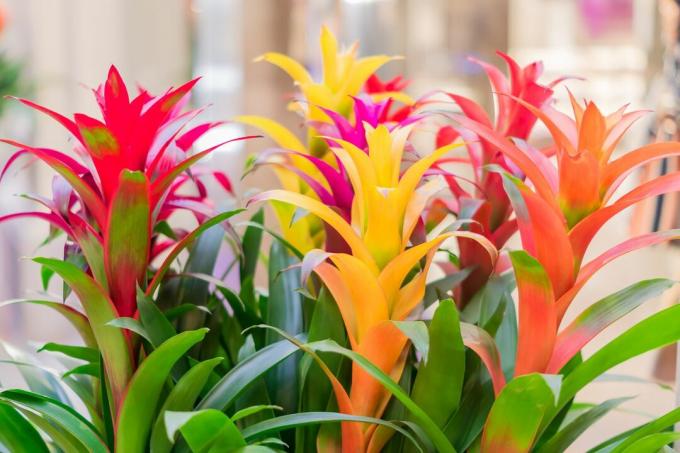
The bromeliad family (Bromeliaceae) includes many species of different shapes and colors. We present the most beautiful ones and show what is important when choosing a location and caring for bromeliads indoor plants. You can also learn how apples can help with flowering.
contents
- Bromeliads: flowering, origin and properties
- The most beautiful bromeliad genera
-
Plants: location, timing and procedure
- The right location
- The right substrate
-
Care of bromeliads
- Water, fertilize and cut bromeliads
- Bring bromeliads to bloom
- Bromeliad has faded: care after flowering
- Repot properly
- Untie bromeliads
- Are bromeliads hardy?
-
grow bromeliads
- Bromeliad offshoots
- Propagation via seeds
- Are bromeliads poisonous?
Bromeliads: flowering, origin and properties
The bromeliads (Bromeliaceae) are a family of plants that - depending on the system - include at least 2100 different species. These are evergreen, herbaceous and perennial plants. In nature, most bromeliads are found in the rainforest, more precisely in the tropical and subtropical regions of South and Central America, where they are native. Some species also prefer higher mountainous regions. In the forests, some species grow terrestrially on the ground, but most grow epiphytically on trees. Here the bromeliads benefit from the sunlight that can hardly reach the floor of the rainforests. Bromeliads usually grow in rosettes and catch rainwater with their funnel-shaped leaves. Dead leaves or bird droppings can also collect in the plant and provide the bromeliad with nutrients.
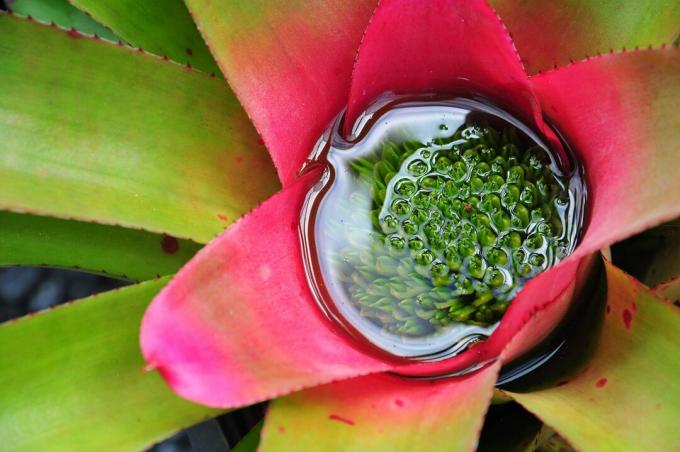
Some bromeliads even offer aquatic plants and frogs a habitat with their funnel leaves. With their roots, the bromeliads find support in the ground or on branches without harming the trees. Bromeliads are plants that can often be kept indoors. They are available in a wide variety of colors. However, the conspicuous leaves are not the flower, but colored bracts. The flower itself is rather inconspicuous and shaped like panicles, racemes or spikes. The bromeliad can flower for several months. However, once it has flowered, the plant dies. However, daughter plants have formed over time, which can now be cared for. The most well-known bromeliad is the pineapple, which is why the plant family is also known as the pineapple family.
tip: With a bit of luck, a pineapple can also grow into a plant. Simply cut off the green stalk of the fruit, let it dry for a day and plant it in a pot with soil.

The most beautiful bromeliad genera
There are numerous bromeliad genera, species and varieties that look different and some can also be kept as houseplants. We introduce you to the most beautiful bromeliads.
- genus Guzmania: This is a genus of plants within the bromeliad family that is particularly popular as a houseplant. There are different Guzmania- Varieties in colors from bright red to yellow to purple or white. Even bicolored bracts are possible. The genus grows epiphytically in nature, i.e. as a non-parasitic sitter on trees.
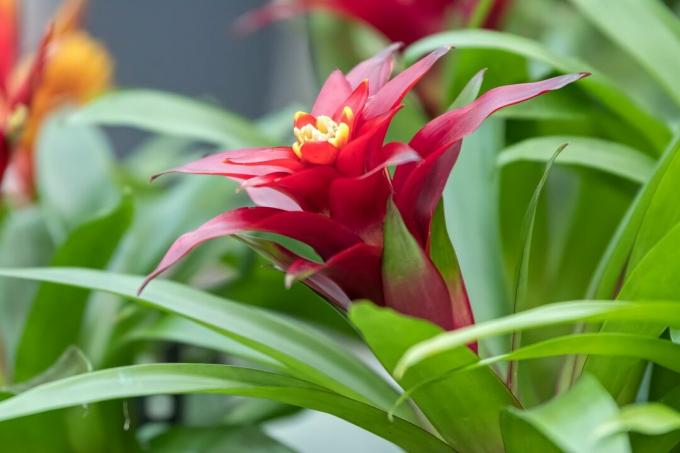
- genus aechmea: The genus aechmea are not only available in different colors, but also with bright patterns on their pointed leaves. It is sometimes referred to as the lance rosette because of its leaves. Here, too, most species are epiphytes, i.e. epiphytic plants.
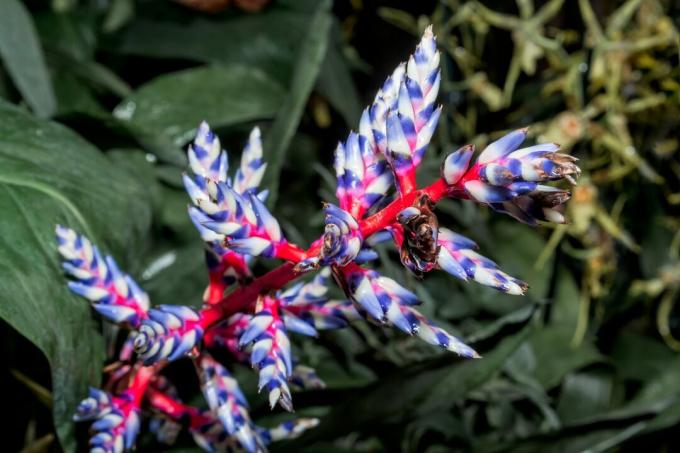
- genus Vriesea: Because of its interesting bracts, this epiphytic bromeliad genus is also called "flaming sword". There are varieties in different colors. The bracts appear like flat ears of corn and are reminiscent of a sword in shape.
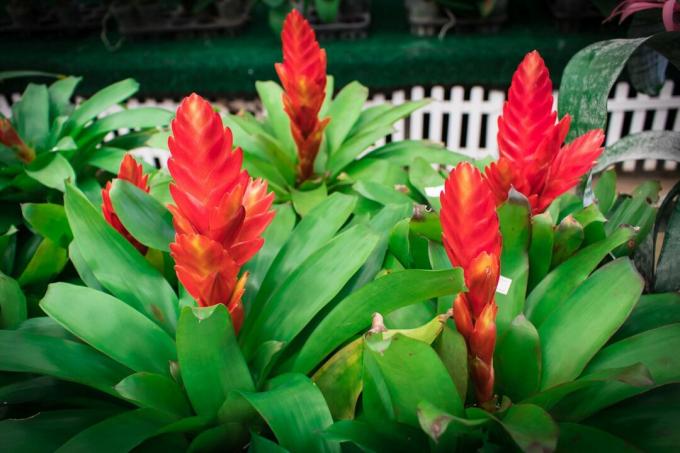
- genus pineapple: This is probably the best-known genus of the bromeliads and is also available as a houseplant. The genus forms fruits, which remain quite small and are more suitable for decoration than for consumption. The plants belong to the terrestrial bromeliads, so they grow on the ground and not on trees.
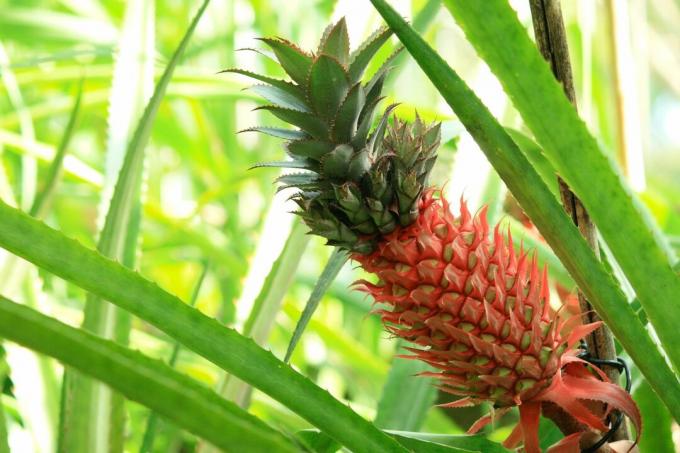
- genus Tillandsia: Within this genus there are the gray and the green tillandsia. The gray species are more likely to be found in dry areas and grow epiphytically, while the green species prefer moist regions and are found growing on the ground. The leaves are usually narrow and pointed. Again, there are varieties with bracts in different colors.
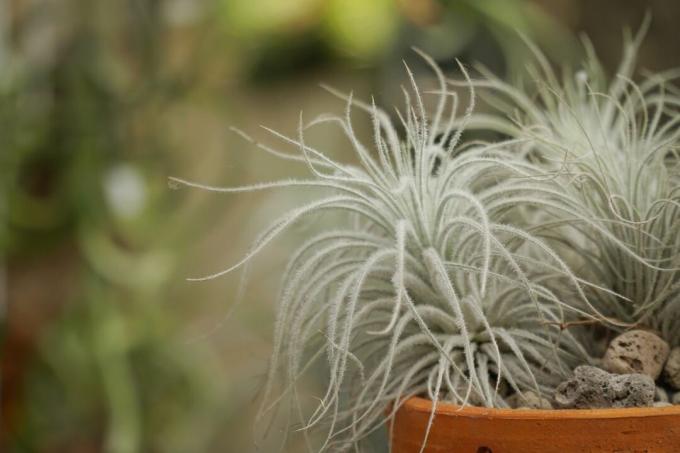
Plants: location, timing and procedure
The bromeliads as houseplants that you can buy commercially are actually always forms that come from the tropics and need a corresponding climate. It is therefore important to ensure that it is always warm, humid and bright.
The right location
A bright place without direct sunlight at midday is therefore suitable as a location for the bromeliad. The weaker morning and evening sun, on the other hand, is good for the bromeliads and can stimulate flowering. Gray tillandsia, on the other hand, prefer a location in full sun. The temperature should be around 20°C or more at all times and should not drop below 18°C. Since high humidity is also important, bromeliads are well suited for bright bathrooms, for example. But it can also be kept in other rooms if you spray the plant regularly with water. Alternatively, place a bowl of water near the bromeliad or on top of the heater.
tip: If it is warm enough in summer, bromeliads can also be placed outside. But then it must not be colder than 15 °C at night. Or you bring the plant back into the apartment in the evening.
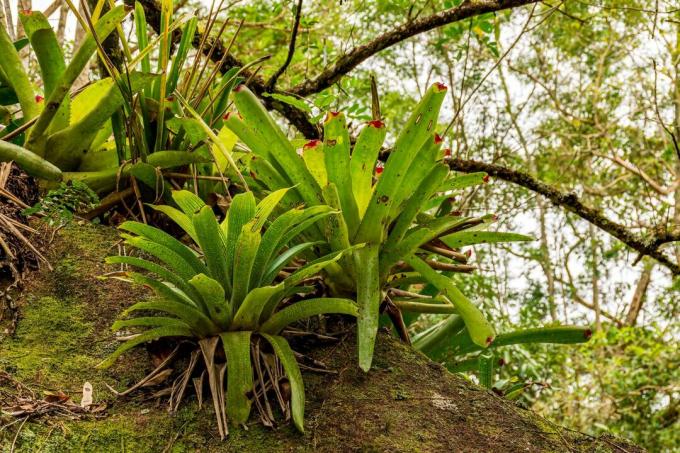
The right substrate
Depending on whether bromeliads grow epiphytic or terrestrial, they need different substrate.
Epiphytic bromeliads some hardly form any roots and absolutely need an airy substrate that gives them support but saves little water. For example, a mixture of one part dried peat moss and two parts bark is suitable for this. It is even possible with some types of bromeliads just to keep them in stones.
Epiphytic bromeliads can also be kept very well in the terrarium. To do this, you should wrap the bromeliad at the root with moss to improve the supply of water. The whole thing can then be tied to a branch in the terrarium with the help of wire or fishing line and should be well moistened. If there are holes or gaps in the branch, such places are of course also suitable for putting the bromeliad in. After about four weeks, roots should have formed. When these are long enough for the bromeliad to hold itself to the branch, you can remove the wire.

The substrate for the terrestrial bromeliads must above all be permeable and slightly acidic. It is therefore best to plant the bromeliad in acidic soil. Our Plantura Organic Acid Soil with its low pH value of 4.6 – 5.4, for example, is ideally suited. It consists of natural raw materials and is therefore not only environmentally friendly, but also harmless to animals. For even better permeability, you can mix the acidic potting soil with sand and pine bark with a size of 7 – 15 mm in a ratio of 2:1:2 and thus offer the bromeliad optimal conditions.
Care of bromeliads
When it comes to bromeliad care, watering is of particular interest, here you should keep the natural water supply via rainwater in mind. As long as the humidity is high enough, not much can actually go wrong when caring for bromeliads.
Water, fertilize and cut bromeliads
to water: In the rain forests, the bromeliads absorb rainwater with their funnel-shaped leaves. For room bromeliads, too, low-lime, room-warm water and, ideally, rainwater should be used. The irrigation water is then poured directly into the leaf funnel and completely replaced once a month. How often you need to water the bromeliad depends on the species and location. More water is needed in summer than in winter.
In addition, the substrate should also be kept moist. If the bromeliad grows without a substrate, it only needs to be sprayed regularly with water. This should happen every day in the summer and less frequently in the winter, about once a week. Terrestrial species are poured directly into the substrate.

Fertilize: To fertilize bromeliads, a liquid fertilizer is suitable, which can be administered via the irrigation water for each species. For example, a biological choice is ours Plantura organic indoor and green plant fertilizer, which consists of natural raw materials and supports leaf and root growth. Since bromeliads do not have high nutrient requirements, you should only fertilize at half the concentration.
Fertilizer can be applied about every two weeks in the summer months. Tillandsia and attached bromeliads require fewer nutrients. Fertilization every four weeks is sufficient here, with a fertilizer dosage of 25%.
Cut: The bromeliad does not need to be cut back. It is also best to just leave dried leaves and wait until they are shed.

Bring bromeliads to bloom
There is a simple trick to getting bromeliads to bloom. The formation of flowers is stimulated by the gas ethylene, which is also given off by some ripening fruit varieties.
- Place an apple or banana in or near the bromeliad pot.
- The location should be as bright and warm as possible.
- Cover the whole thing with a jar or plastic bag to speed up the process.
- After about three weeks, the apple and bag can be removed.
- Now care for the plant as before, with sufficient water, humidity and occasional fertilizer.
- Flowering should begin after about two months.

Bromeliad has faded: care after flowering
If the bromeliad has faded, it should never be disposed of immediately if you want to continue to enjoy the plant. During dieback, small nightcomes are formed at the base that require further care. Water and fertilize the mother plant as you normally would until the childlets — as the daughter plants are called — are big enough to stand in their own pot. To learn how to separate the kindles from the plant, see the Bromeliad Propagation section below. The withered mother plant can be discarded, the children are planted and cared for like mature bromeliads.
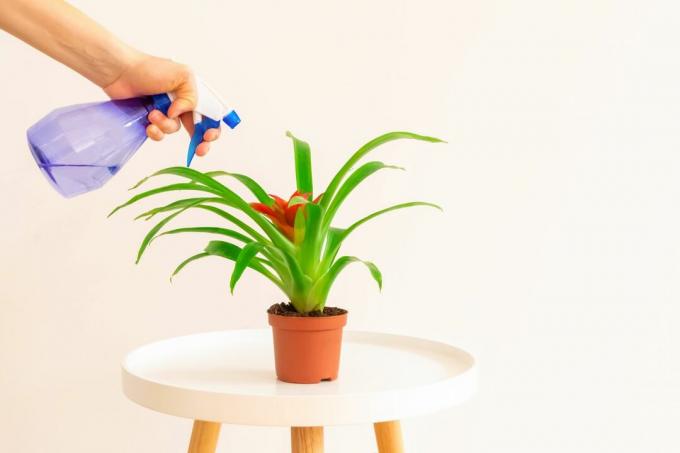
Repot properly
When bromeliads get too big for their pot or lose their footing, it's time to repot. This is best done in spring, just before the start of the growing season. For this purpose, a larger vessel is simply chosen, which, depending on the type, is filled with a layer of potsherds and then with a layer of suitable substrate. Now the plant is used and the gaps are filled with substrate. The whole thing is pressed lightly to give the plant support. Even after purchase, bromeliads should be repotted immediately, as the original substrate is often not suitable for the long term.
Untie bromeliads
If you have chosen an epiphytic bromeliad species, the plant does not necessarily need substrate. It can also be tied to a branch, for example in a terrarium. You can find out how to untie the bromeliad below:
- Wrap the base of the bromeliad in moss.
- Secure with wire or fishing line.
- Tuck the bromeliad into a knot or crevice, or simply tie the plant to the branch with the wire.
- Moisten the moss sufficiently and care for the epiphytic bromeliad as usual.
- When the roots are established enough for the bromeliad to hold itself, the wire is removed.
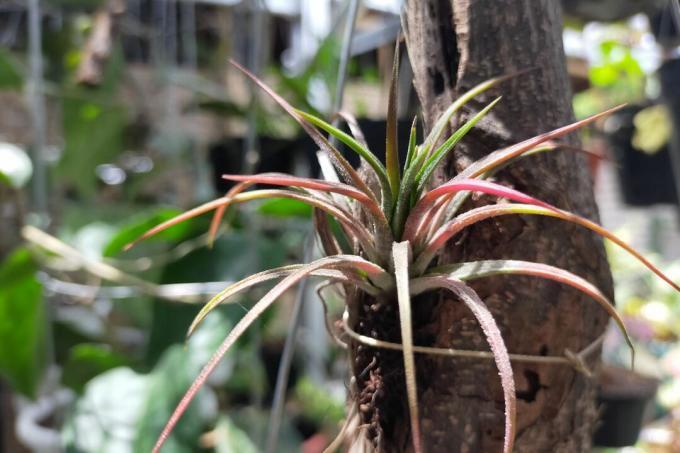
Are bromeliads hardy?
Bromeliads are not hardy. They need temperatures above 14°C in winter to prevent them from dying. Between October and March they are in a dormant phase. This means that growth is largely stopped. In winter you therefore have to water less and there is no need to add fertilizer.
grow bromeliads
bromeliadoffshoot
There is a very simple method to propagate bromeliads. After flowering, bromeliads form offshoots, which are also known as kindles. These can easily be used to propagate the plant. Until the children have reached a size of about 10 cm, the mother plant should be cared for as usual. If the offshoots are large enough, they can be separated from the mother plant with a sharp knife. Then the bromeliad children are planted in separate pots with a suitable substrate and placed in a bright and warm place. To improve the humidity and thus the growing conditions at the beginning, put a glass or plastic bag over the plant. Pour and fertilize like adult specimens. If the child forms new leaves, the propagation was successful and the bag can be removed.
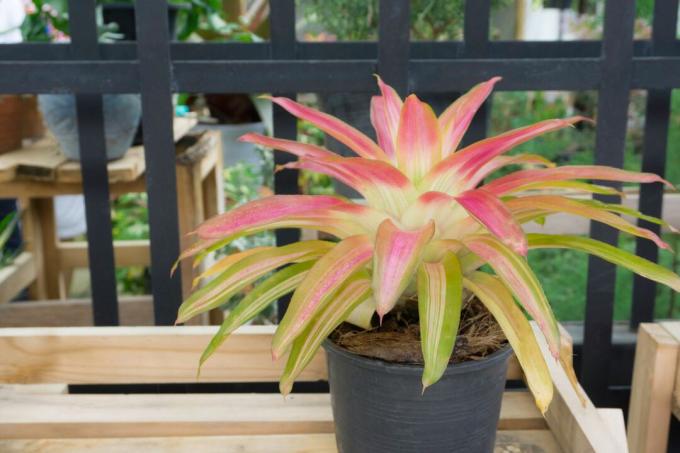
Propagation via seeds
Propagation from seeds is not always successful with bromeliads. To germinate, the seed needs a constant temperature of around 25 °C and a bright place. The seeds are light germinators and must therefore not be covered with substrate. The substrate can be, for example, a mixture of sphagnum moss and the expanded clay mineral vermiculite, which is well moistened. The seeds are spread out on this in the spring and lightly pressed. Now cover the whole thing with cling film to increase the humidity. Germination can start after about 14 days. Foil coverage should be maintained, however, until some leaves have formed. The little plants can then be gradually hardened off. This means they get used to lower humidity and eventually repotted. For this purpose, the cling film should be aired by the hour at the beginning. The phases without cover can then become longer and longer until the seedlings have finally got used to the lower humidity in the room.
Are bromeliads poisonous?
With the exception of unripe pineapples, bromeliads are not poisonous. Only the pointed leaves can pose a small danger to children and pets.
Most orchids also grow epiphytically and are propagated by Kindel. Watch our video guide to learn how Propagating orchids over Kindel can.



